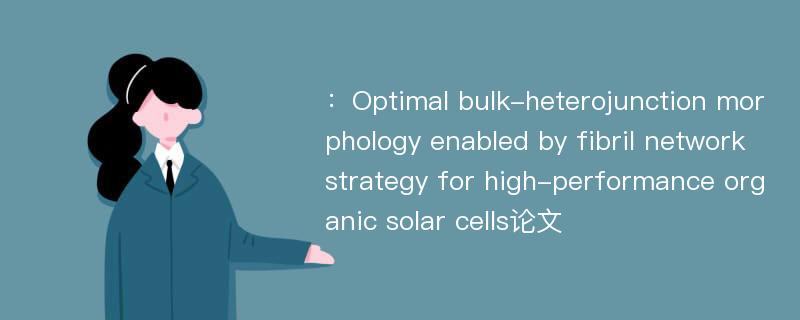
本文主要研究内容
作者(2019)在《Optimal bulk-heterojunction morphology enabled by fibril network strategy for high-performance organic solar cells》一文中研究指出:A bicontinuous network formed spontaneously upon film preparation is highly desirable for bulk-heterojunction(BHJ) organic solar cells(OSCs). Many donor-acceptor(D-A) type conjugated polymers can self-assemble into polymer fibrils in the solid state and such fibril-assembly can construct the morphological framework by forming a network structure, inducing the formation of ideal BHJ morphology. Our recent works have revealed that the fibril network strategy(FNS) can control the blend morphology in fullerene, non-fullerene and ternary OSCs. It has been shown that the formation of fibril network can optimize phase separation scale and ensure efficient exciton dissociation and charge carriers transport, thus leading to impressive power conversion efficiencies(PCEs) and high fill factor(FF) values. We believe that FNS will provide a promising approach for the optimization of active layer morphology and the improvement of photovoltaic performance, and further promote the commercialization of OSCs.
Abstract
A bicontinuous network formed spontaneously upon film preparation is highly desirable for bulk-heterojunction(BHJ) organic solar cells(OSCs). Many donor-acceptor(D-A) type conjugated polymers can self-assemble into polymer fibrils in the solid state and such fibril-assembly can construct the morphological framework by forming a network structure, inducing the formation of ideal BHJ morphology. Our recent works have revealed that the fibril network strategy(FNS) can control the blend morphology in fullerene, non-fullerene and ternary OSCs. It has been shown that the formation of fibril network can optimize phase separation scale and ensure efficient exciton dissociation and charge carriers transport, thus leading to impressive power conversion efficiencies(PCEs) and high fill factor(FF) values. We believe that FNS will provide a promising approach for the optimization of active layer morphology and the improvement of photovoltaic performance, and further promote the commercialization of OSCs.
论文参考文献
论文详细介绍
论文作者分别是来自Science China(Chemistry)的,发表于刊物Science China(Chemistry)2019年06期论文,是一篇关于,Science China(Chemistry)2019年06期论文的文章。本文可供学术参考使用,各位学者可以免费参考阅读下载,文章观点不代表本站观点,资料来自Science China(Chemistry)2019年06期论文网站,若本站收录的文献无意侵犯了您的著作版权,请联系我们删除。
